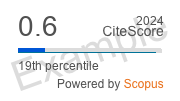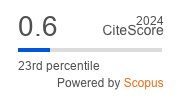Relationship between local and systemic inflammatory response in the early postinfarction period
https://doi.org/10.29001/2073-8552-2025-2707
Abstract
Introduction. Radionuclide imaging of somatostatin receptor type 2 (SSTR-2) shows great promise as a novel marker of cardiovascular inflammation. However, it is still unclear whether local inflammation and high levels of macrophages in the infarct area that overexpress SSTR-2 are positive or negative factors for myocardial healing.
Aim. To evaluate the relationship between inflammatory biomarkers as indicators of the systemic response to ischemic injury and the local inflammatory response in the myocardium, as measured by SSTR-2-targeted imaging, during the early post- infarction period.
Material and methods. Twenty-three patients with acute primary anterior wall myocardial infarction and ST-segment elevation myocardial infarction (STEMI) were included in the study. On the first day (before PCI) and on the fifth day after AMI, venous blood was collected from all patients to determine hsCRP and IL-6 levels. Five to six days after the acute coronary event, all patients underwent SPECT/CT with 99mTc-Tektrotyd. Seven days after the acute coronary event, they underwent myocardial perfusion scintigraphy with 99mTc-MIBI at rest.
Results. The results of the study indicated a negative correlation between hs-CRP and IL-6 levels on days 1 and 5 with left ventricular ejection fraction (LVEF) and a positive correlation with the summed rest score (SRS). Concurrently, SUVmax exhibited no correlation with hsCRP and IL-6 levels. Concurrently, SUVmax exhibited a moderate correlation with SRS (r = 0.517, p = 0.011). In the context of univariate linear regression, SUVmax demonstrated no statistically significant impact on hs-CRP and IL-6 levels. Concurrently, the total resting perfusion defect score (SRS) exerted an influence on the alteration in the levels of inflammatory biomarkers. It is also noteworthy that no regression relationship was identified between SUVmax and SRS.
Conclusion. The findings indicated that the intensity of accumulation of somatostatin analog 99mTc-Tectrotyd in the left ventricular myocardium during the early postinfarction period is not associated with the levels of inflammatory biomarkers. Our findings indicate the activation of cellular and biochemical pathways of the inflammatory cascade. Conversely, the study identified a potential anti-inflammatory function of somatostatin receptor type 2 hyperexpression.
Keywords
About the Authors
Ju. N. IlyushenkovaRussian Federation
Julia N. Ilyushenkova – PhD, senior researcher, Nuclear medicine department
111a Kievskaya str, Tomsk, 634012, Russian Federation
A. A. Trusov
Russian Federation
Andrey A. Trusov - postgraduate student, Emergency cardiology department
111a Kievskaya str, Tomsk, 634012, Russian Federation
E. S. Kravchenko
Russian Federation
Elena S. Kravchenko - junior researcher, clinical laboratory diagnostics department
111a Kievskaya str, Tomsk, 634012, Russian Federation
V. V. Ryabov
Russian Federation
Vyacheslav V. Ryabov – Professor, Head of emergency cardiology department
111a Kievskaya str, Tomsk, 634012, Russian Federation
S. I. Sazonova
Russian Federation
Svetlana I. Sazonova – PhD, Head of Nuclear medicine department
111a Kievskaya str, Tomsk, 634012, Russian Federation
References
1. Рябов В.В., Попов С.В., Вышлов Е.В., с соавт. Реперфузионное повреждение сердца. Роль микроваскулярной обструкции. Сибирский журнал клинической и экспериментальной медицины. 2023;38(2):14-22. doi:10.29001/2073-8552-2023-39-2-14-22
2. Ashraf S, Farooq U, Shahbaz A, et al. Factors Responsible for Worse Outcomes in STEMI Patients With Early vs Delayed Treatment Presenting in a Tertiary Care Center in a Third World Country. Curr Probl Cardiol. 2024;49(1 Pt B):102049. doi:10.1016/j.cpcardiol.2023.102049
3. Akhtar KH, Khan MS, Baron SJ, et al. The spectrum of post-myocardial infarction care: From acute ischemia to heart failure. Prog Cardiovasc Dis. 2024;82:15-25. doi:10.1016/j.pcad.2024.01.017
4. Vörös I, Sághy É, Pohóczky K, et al. Somatostatin and Its Receptors in Myocardial Ischemia/Reperfusion Injury and Cardioprotection. Front Pharmacol. 2021;12:663655. Published 2021 Nov 5. doi:10.3389/fphar.2021.663655
5. Tarkin JM, Joshi FR, Evans NR, et al. Detection of Atherosclerotic Inflammation by 68 Ga-DOTATATE PET Compared to [ 18 F]FDG PET Imaging. J Am Coll Cardiol. 2017;69(14):1774-1791. doi:10.1016/j.jacc.2017.01.060
6. Sazonova SI, Ilyushenkova JN, Syrkina AG, et al. Potential utility of SPECT/CT with 99mTc-Tektrotyd for imaging of post-myocardial infarction inflammation. J Nucl Cardiol. 2023;30(6):2544-2555. doi:10.1007/s12350-023-03312-5
7. Hilgendorf I, Frantz S, Frangogiannis NG. Repair of the Infarcted Heart: Cellular Effectors, Molecular Mechanisms and Therapeutic Opportunities. Circ Res. 2024;134(12):1718-1751. doi:10.1161/CIRCRESAHA.124.323658
8. Yan X, Anzai A, Katsumata Y, et al. Temporal dynamics of cardiac immune cell accumulation following acute myocardial infarction. J Mol Cell Cardiol. 2013;62:24-35. doi:10.1016/j.yjmcc.2013.04.023
9. Zuo W, Sun R, Ji Z, Ma G. Macrophage-driven cardiac inflammation and healing: insights from homeostasis and myocardial infarction. Cell Mol Biol Lett. 2023;28(1):81. Published 2023 Oct 19. doi:10.1186/s11658-023-00491-4
10. Toner YC, Ghotbi AA, Naidu S, et al. Systematically evaluating DOTATATE and FDG as PET immuno-imaging tracers of cardiovascular inflammation. Sci Rep. 2022;12(1):6185. Published 2022 Apr 13. doi:10.1038/s41598-022-09590-2
11. Sazonova SI, Syrkina AG, Mochula OV, Anashbaev ZZ, Popov EV, Ryabov VV. Subacute myocardial infarction detected by technetium-99m-labeled somatostatin analog scintigraphy. J Nucl Cardiol. 2022;29(6):3586-3589. doi:10.1007/s12350-021-02644-4
12. Ryabov VV, Trusov AA, Kercheva MA, et al. Somatostatin Receptor Type 2 as a Potential Marker of Local Myocardial Inflammation in Myocardial Infarction: Morphologic Data on Distribution in Infarcted and Normal Human Myocardium. Biomedicines. 2024;12(10):2178. Published 2024 Sep 25. doi:10.3390/biomedicines12102178
13. Ćorović A, Gopalan D, Wall C, et al. Novel Approach for Assessing Postinfarct Myocardial Injury and Inflammation Using Hybrid Somatostatin Receptor Positron Emission Tomography/Magnetic Resonance Imaging. Circ Cardiovasc Imaging. 2023;16(1):e014538. doi:10.1161/CIRCIMAGING.122.014538
14. Scărlătescu AI, Micheu MM, Popa-Fotea N, et al. IL-6, IL-1RA and Resistin as Predictors of Left Ventricular Remodelling and Major Adverse Cardiac Events in Patients with Acute ST Elevation Myocardial Infarction. Diagnostics (Basel). 2022;12(2):266. Published 2022 Jan 21. doi:10.3390/diagnostics12020266
15. Cristell N, Cianflone D, Durante A, et al. High-sensitivity C-reactive protein is within normal levels at the very onset of first ST-segment elevation acute myocardial infarction in 41% of cases: a multiethnic case-control study. J Am Coll Cardiol. 2011;58(25):2654-2661. doi:10.1016/j.jacc.2011.08.055
16. Ammirati E, Cannistraci CV, Cristell NA, et al. Identification and predictive value of interleukin-6+ interleukin-10+ and interleukin-6-interleukin-10+ cytokine patterns in ST-elevation acute myocardial infarction. Circ Res. 2012;111(10):1336-1348. doi:10.1161/CIRCRESAHA.111.262477
17. Khalifa AA, El Sokkary NH, Elblehi SS, Diab MA, Ali MA. Potential cardioprotective effect of octreotide via NOXs mitigation, mitochondrial biogenesis and MAPK/Erk1/2/STAT3/NF-kβ pathway attenuation in isoproterenol-induced myocardial infarction in rats. Eur J Pharmacol. 2022;925:174978. doi:10.1016/j.ejphar.2022.174978
18. Armani C, Catalani E, Balbarini A, Bagnoli P, Cervia D. Expression, pharmacology, and functional role of somatostatin receptor subtypes 1 and 2 in human macrophages. J Leukoc Biol. 2007;81(3):845-855. doi:10.1189/jlb.0606417
19. Aziz NM, Ragy MM, Ahmed SM. Somatostatin analogue, Octreotide, improves restraint stress-induced liver injury by ameliorating oxidative stress, inflammatory response, and activation of hepatic stellate cells. Cell Stress Chaperones. 2018;23(6):1237-1245. doi:10.1007/s12192-018-0929-7
20. El-Sisi AEE, Sokar SS, Shebl AM, Mohamed DZ, Abu-Risha SE. Octreotide and melatonin alleviate inflammasome-induced pyroptosis through inhibition of TLR4-NF-κB-NLRP3 pathway in hepatic ischemia/reperfusion injury. Toxicol Appl Pharmacol. 2021;410:115340. doi:10.1016/j.taap.2020.115340
Supplementary files
Review
For citations:
Ilyushenkova J.N., Trusov A.A., Kravchenko E.S., Ryabov V.V., Sazonova S.I. Relationship between local and systemic inflammatory response in the early postinfarction period. Siberian Journal of Clinical and Experimental Medicine. (In Russ.) https://doi.org/10.29001/2073-8552-2025-2707





.png)





























